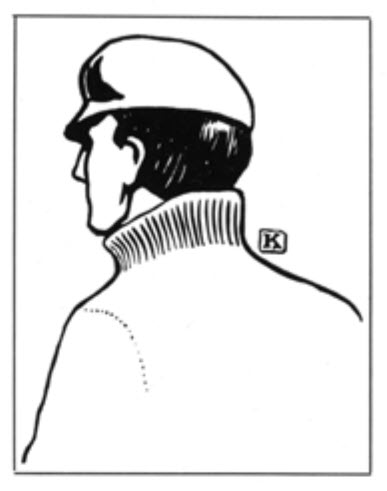Sometimes it’s difficult to write blogs that are close to the heart. I have been struggling with a particular tragedy – or rather a series of them – that befell one of the Kimbrough families. In process of research, as always, I found yet another story, also tragic, but not quite as heartrending as my original subject. I’ll recount it first, in hopes of gaining courage to write the other. In both cases perhaps the overriding tragedy is that unlike other Kimbroughs, neither of these families have descendants so it is unlikely they will be written about unless I do. I must thank cousin Martha for getting me to dig deeper into this family and their lives.
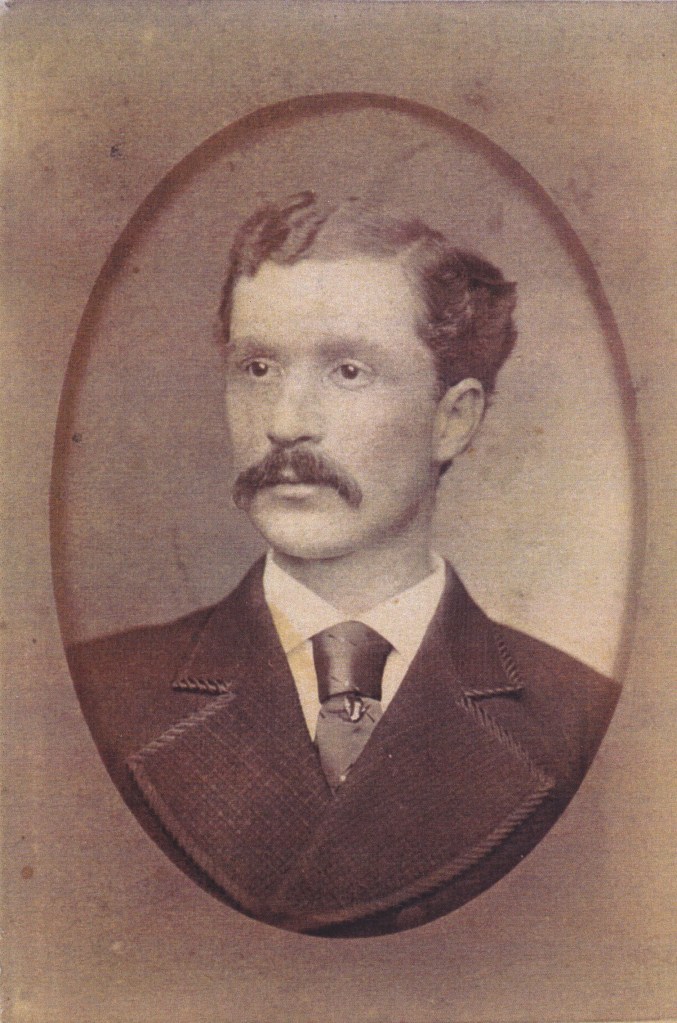
The tale starts out well. Kate Stacker, the socially prominent sister of Clay Stacker, Sr, a Clarksville, Tennessee businessman, married Landen Frank Kimbrough in May of 1874. She was described in the local paper as “one of the loveliest of Clarksville’s young ladies” and her groom as “one of our most industrious and promising young business men”. They were married in the local Episcopal Church, followed by a gathering at the bride’s mother’s home. Male friends gave a reception for them at a local hotel because, as reported by the newspaper: “If they are compelled to lose Land from their sad single circle, they are determined to show that they rejoice in his good fortune, and bear him no malice for leaving them in the vale of bachelorhood”. Gotta’ love the flowery language of the time. Stay tuned for more. Their future looks bright by all accounts.
Landen Frank, or L.F. as he was commonly known, was born in 1852 as part of the large family of Kimbroughs headed by Merideth Garth and Mildred Ann Maria Terry Kimbrough. He had been educated at Kentucky University in Lexington and returned to the Clarksville area to go into business, rather than to farm. He had two older brothers, Tom, who became a physician and married a girl from Nashville, and Judge, who seemed fated to be the farmer. Business was a logical choice.

His early accomplishments appear numerous. In 1872, many of the young men came together and founded the Clarksville Hook and Ladder Company, an all volunteer fire department. In June 1872 L.F. is elected the Secretary of the Hook and Ladder Company.
He is reported to be a clerk in the local Clarksville bank early in 1873. He is named as a bookkeeper at the First National Bank in June of 1877 when he appears with Kate in a description of an anticipated visit to the “Eastern resorts of pleasure”. He is also described in a partnership, Beaumont & Kimbrough, an insurance brokerage in a discussion of a fire in April of that year. Two jobs, perhaps? His partner appears to have been quite a bit older, a director at the bank and a prominent member of the business community concerned with tobacco.
1877 proved to be a pivotal year in the life of L.F., Kate and their newborn son, Frank Richmond. In July of that year, Landen is thanked in the local paper by conventioneers who had stayed at his home. His wife isn’t mentioned, and thanks are extended to his mother and his “interesting little sisters”. Alternately, the business partnership was seemingly ill-fated as it was dissolved in August of 1877 – just three years after L.F. had married and settled in Clarksville with his wife.
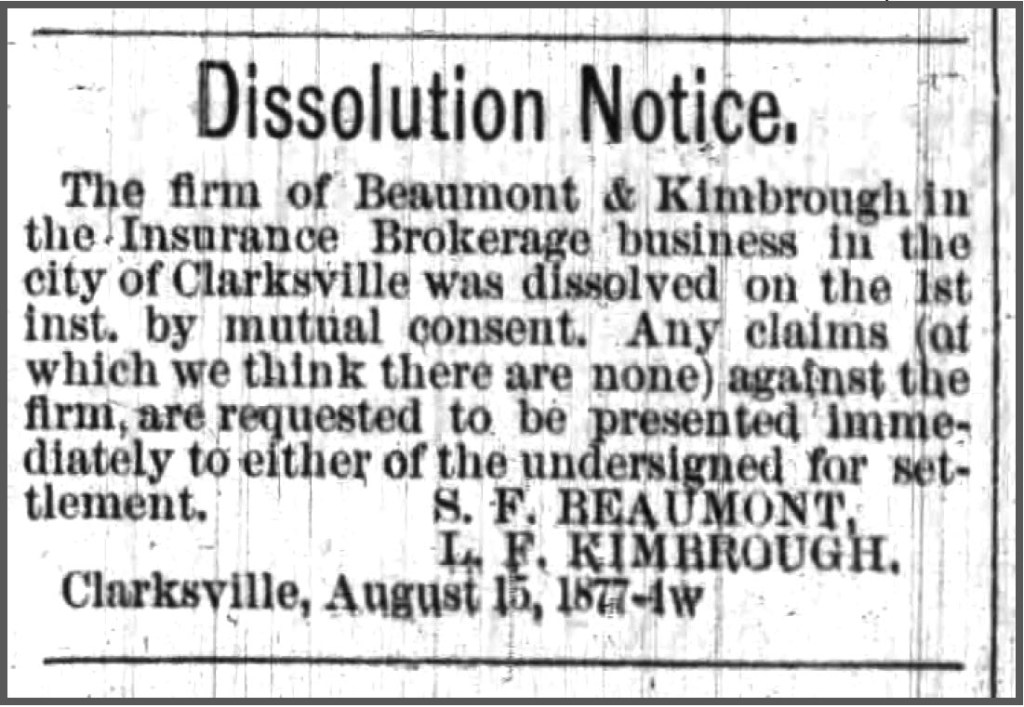
About 3 weeks later that same year his brother-in-law, Clay Stacker, Jr., published a notice in the paper that “All persons having claims against L.F. Kimbrough will please present them to me for settlement”. That is the last we hear of him – L.F. disappears. No further record has been found of him. The only mention of Kimbrough – no initials or any further information – is in a February issue of the papers advising that the “Kimbrough cases” are set for later in the month. So what happened? Perhaps more information will surface later. For right now, after searching many resources, his whereabouts are unknown. No death record is found in the family bible!
His son, Frank Richmond Kimbrough is born in October 1877. No mention of L.F. is found in the life of his son or his wife, including in their obituaries. In 1880, the census lists Kate Stacker Kimbrough as a widow. She and her two-year-old son are living with her mother and the extended family.

Twenty years later, Kate had died and Frank, or Richmond as he was often known, had begun his career. After Kate’s death in 1893 he attended school at Sewanee College from 1894 to 1896, and then went to New York City to study at the Art Students League. He was a prominent student and alumni of Sewanee and continued to contribute to the college periodicals with amusing quips and art work.
In September of 1898 he went to England to pursue his art under Sir Hubert Herkomer, the most famous living portrait painter of the time. He lived at the home of his mentor, called Lululuand in Burshey, Hereford, England.

The building housed Herkomer’s studio and an art school. It was designed in the Romanesque style and was nicknamed the “Bavarian Castle” by Bushey residents. One could imagine that young Kimbrough’s life there was rich with possibilities to meet prominent people and pursue his creativity with a wealth of support.
F. Richmond consistently demonstrated his connection and affection for Sewanee with contributions to the college periodicals.His illustrations are scattered through out the period publications.
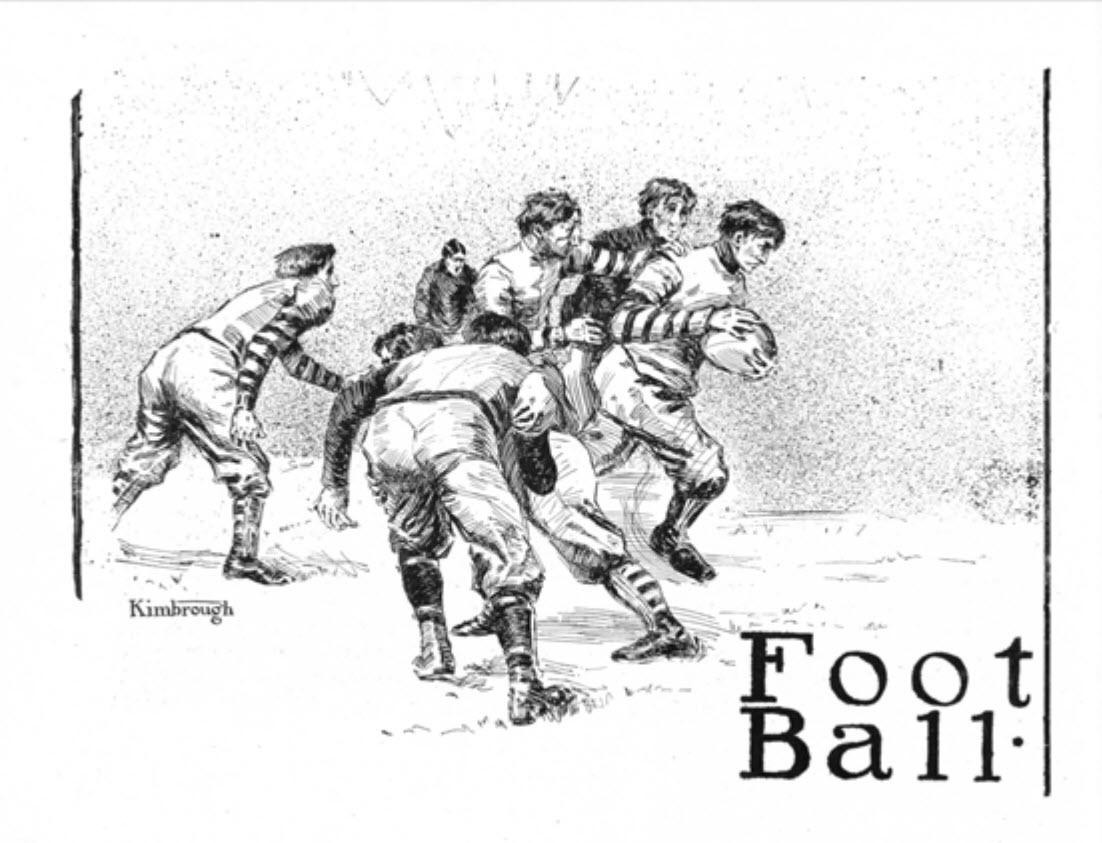
Sewanee Athletic Souvenir from 1901
An example of his wit appears in the 1901 Cap and Gown. In a want ad format near the back of the publication appears the following: “F.R. Kimbrough announces that he will introduce a select party of eligible young men into mazes of London Society. Mr. Kimbrough’s intimacy with Burke’s Peerage renders him eminently qualified for the task”. Was this a poke at the numbers of daughters of social climbing newly rich who were being sent to England to find titled husbands? In another “ad” he described himself as “Artist and Friend to Celebrities, London, Paris and Sewanee”.
He last visited home beginning Thanksgiving of 1901. In April of 1902 he gave a “studio tea” at the home of (now) General and Mrs. Clay Stacker that was reported to be “an elegant affair and a very novel function in Clarksville society” where he showed some of his work to friends and family. According to the newspaper report his work shown was comprised of book cover designs, oil sketches, pencil sketches and water colors.
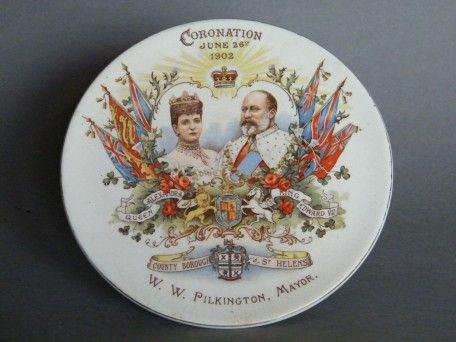
He returned to England in time for the Coronation celebration. A souvenir badge from the coronation of King Edward VII, on June 26, 1902 carries the following label: From F. Richmond Kimbrough, associate of Charles Dana Gibson. Artist and friend to celebrities, indeed.
One account reports that F.R. contracted a cold at the Coronation Celebration which led to his pneumonia, but the time doesn’t seem right. The Clarksville paper reports that on the Saturday before Christmas 1902, Kimbrough had gone to Harrow Weald Park, in Middlesex County, the home of Mr. John M. Hughes, where he was an “ever-welcome guest”. On Sunday he was taken ill, and when, on the next day, pneumonia developed, his physician called in a specialist from London, and two trained nurses. On Christmas morning he died. In less than 5 days he had passed. His body was carried home to Burshey, by his friends, who were with him when he died. On December 31, funeral services were held in All Saints’ Church, in the West End of London.

As requested in his will, his remains were put aboard a ship and transported to New York where they were met by his uncle, General Clay Stacker, Mr. and Mrs. B. L. Rice, and fourteen of his college friends and comrades, three of whom came on to Clarksville for the services. The remains were transported by train to Clarksville where another funeral service was held. Not an easy task, but Uncle Clay managed to fulfill Richmond’s wish to be buried in Greenwood Cemetery near his mother, as well as serving as his executor.

courtesy Sewanee, University of the South
His will contained a large number of bequests and requests. His estate was considerable despite his age, and in addition to family members both his church and the college received funds. The institutions were requested to construct memorial windows in his honor. One window was placed in the Alpha Tau Omega Chapter House and a window was also placed in the Trinity Church in December of 1903. The picture below is thanks to cousin Martha who started it all.

He is eulogized, as well, in the Cap and Gown 1903 from Sewanee College.
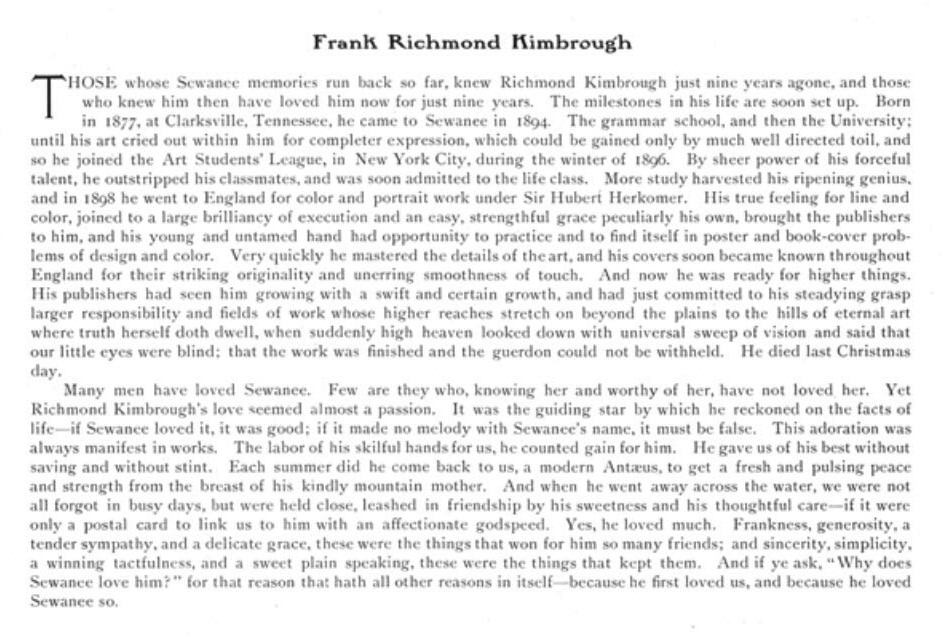
In his short life, and without the support of his father, Frank Richmond Kimbrough made a rather large mark on the world. In retrospect he may have had a large ego, but appeared to live up to many of his aspirations within the time allotted. It’s interesting to muse on what his descendants might have been like.


